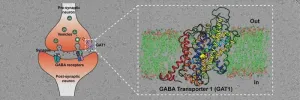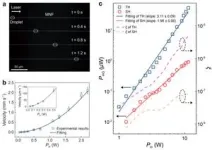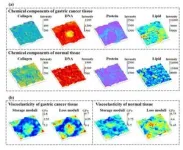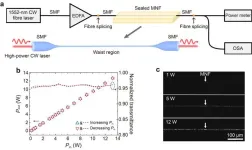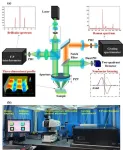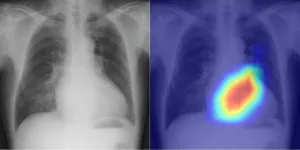(Press-News.org) Using Cryo-EM, a powerful microscopy technique, researchers at IISc and collaborators have decoded the molecular architecture of a transporter protein controlling the movement of a key neurotransmitter.
Neurons or nerve cells communicate by releasing chemical signals called neurotransmitters. Each neurotransmitter can activate specific sets of proteins called receptors that in turn either excite or inhibit neural communication. A balance between excitation and inhibition is vital for the neural circuitry to maintain normal structure and function. Imbalances in excitatory or inhibitory inputs can result in disorders like seizures, anxiety, and schizophrenia.
The inhibitory neurotransmitter Gamma-aminobutyric acid or GABA balances out the excitatory inputs from glutamate, another neurotransmitter. GABA-driven signaling at the neural synapses (junctions between neurons) is modulated by GABA receptor proteins that interact with GABA released from the preceding neurons in the circuit. Excess GABA released into the neural synapses needs to be recycled into neurons and surrounding glial cells for subsequent release events to happen. GABA transporters (GATs) are the primary molecules involved in this step – they employ sodium and chloride ions to move excess GABA back into the neurons. GATs are therefore vital molecules that orchestrate GABA signaling and function. They are, therefore, an important target for the treatment of conditions like seizures.
The current study, led by Aravind Penmatsa, Associate Professor in the Molecular Biophysics Unit (MBU), IISc, deciphers the molecular architecture of GAT using cryo-electron microscopy. The technique has the capacity to image and reconstruct the structure of biomolecules that are more than a million times smaller than the width of a human hair.
The researchers purified GAT and used a novel approach to create an antibody site on this molecule. Antibodies help increase the mass of proteins and facilitate improved imaging through cryo-EM. The team was able to observe that the GAT structure was facing the cytosol – the inside of the cell – and was bound to a GABA molecule, sodium and chloride ions. This binding is one of many key steps in the GABA transport cycle; deciphering it can provide vital insights into the mechanisms of GABA recognition and release into neurons.
The availability of high-resolution GAT structures is crucial for developing specific blockers of GABA uptake for treatment of epilepsies. It would also aid in studying how drugs prescribed to block GABA uptake interact with GATs.
END
Cracking the structure of a crucial neural transport protein
2023-07-07
ELSE PRESS RELEASES FROM THIS DATE:
High-power optical continuous-wave waveguiding in a silica micro/nanofibre
2023-07-07
Optical MNFs are cylindrical optical waveguides with diameter below or close to the wavelength of the light. Since its first experimental demonstration [Nature 426, 816 (2003)], low-loss silica MNF has been attracting increasing attention in wide applications from optical sensors, atom optics, nonlinear optics to optomechanics. Generally, increasing the waveguiding mode power is the most effective approach to enhance light-matter interaction, and explore new opportunities for both scientific research and technological applications. However, the highest CW mode power reported so far in a MNF is ~0.4 W [AIP Adv. 4, 067124 (2014)], with typical waveguiding ...
Laser differential confocal Raman-Brillouin spectrum microscopy
2023-07-07
There are obvious differences between cancerous cells and normal cells in morphology, chemical properties and mechanical properties. The detection of cytochemical and mechanical properties of tumor tissues can provide multi-dimensional information for the pathological process of cells and human tissues. Among the existing detection methods for the morphology, mechanics and chemical properties of tissue and cells, confocal Raman spectroscopy can detect the chemical properties of micro-regions of samples without contact and label, and confocal Brillouin spectroscopy can detect ...
New Zealand kids spending one-third of after-school time on screens
2023-07-07
Regulations are urgently needed to protect children from harm in the unregulated online world, researchers at the University of Otago, New Zealand, say.
The call comes as the researchers publish the results of their study into the after-school habits of 12-year-olds. Their research, published today in the New Zealand Medical Journal, finds children are spending a third of their after-school time on screens, including more than half their time after 8pm.
Senior researcher Dr Moira Smith from the University's Department ...
It worked in the Caribbean – What about here?
2023-07-07
While there is extensive data on the high rates of HIV, STIs and unintended pregnancies among Black populations in the U.S., this racial category problematically subsumes the ethnic diversity of immigrant Black populations. Today, one in ten Black people in the U.S. are immigrants, with Caribbean immigrants accounting for approximately 46% of the total Black immigrant population.
It can’t be assumed that the variety of effective behavioral interventions (EBIs) that exist to address sexual and reproductive health for Black populations will be effective with Afro-Caribbean ...
Global diet study challenges advice to limit high-fat dairy foods
2023-07-07
Sophia Antipolis, 7 July 2023: Unprocessed red meat and whole grains can be included or left out of a healthy diet, according to a study conducted in 80 countries across all inhabited continents and published today in European Heart Journal, a journal of the European Society of Cardiology (ESC).1 Diets emphasising fruit, vegetables, dairy (mainly whole-fat), nuts, legumes and fish were linked with a lower risk of cardiovascular disease (CVD) and premature death in all world regions. The addition ...
Not eating enough of these six healthy foods is associated with higher cardiovascular disease and deaths globally
2023-07-07
HAMILTON, ON (July 6, 2023) – A study led by McMaster University and Hamilton Health Sciences researchers at the Population Research Health Institute (PHRI) has found that not eating enough of six key foods in combination is associated with a higher risk of cardiovascular disease (CVD) in adults.
Consuming fruits, vegetables, legumes, nuts, fish and whole-fat dairy products is key to lowering the risk of CVD, including heart attacks and strokes. The study also found that a healthy diet can be achieved in various ways, ...
Vaccine candidate prevents diarrhea, improves growth in animal model
2023-07-07
PORTLAND, Oregon -- A vaccine originally developed to prevent bacteria-caused diarrhea has now also been found to help infant nonhuman primates grow faster, according to a new study published in Nature Communications.
“The 160 million people worldwide who get sick every year from Campylobacter bacteria is far too many,” said the study’s lead researcher, Mark Slifka, Ph.D., a professor at Oregon Health & Science University’s Oregon National Primate Center. “We need a new tool to prevent bacterial diarrhea in babies and to enable more children to grow into healthy adults, and this vaccine approach looks ...
Queensland native forestry can help achieve global environment goals
2023-07-07
Research conducted by The University of Queensland has revealed that Queensland native forestry, including timber harvesting, could actually help conserve biodiversity and mitigate climate risks.
Dr Tyron Venn from UQ’s School of Agriculture and Food Sustainability reviewed more than 350 publications, studying the ecological and economic impacts of Queensland native forest management, which includes everything from fire management to timber harvesting.
“Stopping forestry in Queensland’s native forests may sound like a positive outcome for the environment, but the research suggests that it would further shift our impacts offshore and increase ...
Immunotherapy for ‘difficult to treat’ lung cancer patients improves long-term survival
2023-07-07
A global study, led by UCL and UCLH and sponsored by Roche, has shown that the cancer immunotherapy atezolizumab1 significantly improved the overall survival of advanced stage non-small cell lung cancer patients who were not able to be treated with platinum-containing chemotherapy, when compared to single-agent chemotherapy.
The trial results, published today in The Lancet, are good news for non-small cell lung cancer patients who are not eligible for standard of care platinum-based chemotherapy, due to concerns about their ability to withstand ...
AI finds a way to people’s hearts (literally!)
2023-07-07
Body
Osaka, Japan - AI (artificial intelligence) may sound like a cold robotic system, but Osaka Metropolitan University scientists have shown that it can deliver heartwarming—or, more to the point, “heart-warning”—support. They unveiled an innovative use of AI that classifies cardiac functions and pinpoints valvular heart disease with unprecedented accuracy, demonstrating continued progress in merging the fields of medicine and technology to advance patient care. The results will be published in The Lancet Digital ...
